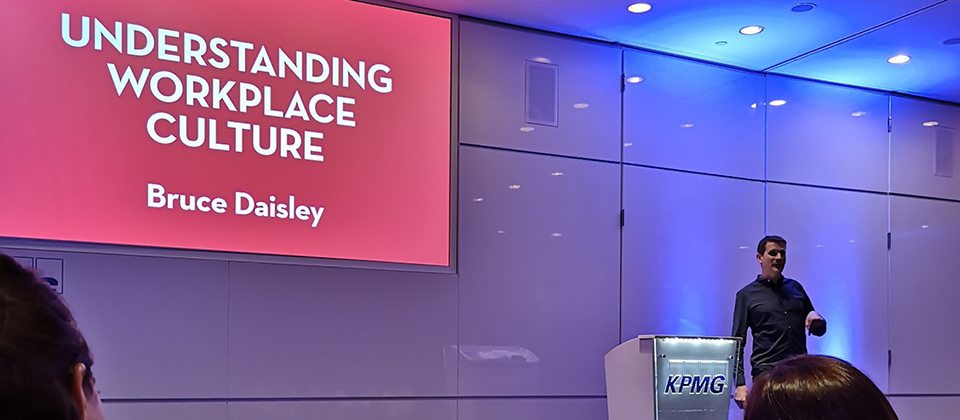What happens in a rat’s brain when it encounters a cat hair? Why does Aaron Sorkin take eight showers a day? We spent an evening with Bruce Daisley and IoIC to find out.
Bruce Daisley has two uncomfortable realities for you. Number one: the always-on, ever-connected nature of work is stressing us out and killing our creative drives. Number two: the consequences of artificial intelligence mean that computers will be doing more of our work than ever before, and we need to adapt by owning the more creative aspects of work.
Now put those two realities together and you’ll soon see the problem: we might need to respond to changing technology by becoming more creative, but the technology we use creates a stressful working environment where a creative mindset is harder to achieve.
We’re in a double bind, as Bruce says. Or, as the more cynical among you may be thinking, we’re doomed.
These battling themes of constant connectivity and cowed creativity were present throughout Bruce’s The Joy of Work seminar, hosted by the Institute of Internal Communication in London last week.
But it isn’t all doom and gloom. Currently Vice President for Europe at Twitter, Bruce has drawn on a wealth of business insight and psychological research to explain how we can put the joy back into work. And Becky Leonard, Sequel’s Communication and Content Manager, was there to find out how. Here’s what she discovered:

Rats will play around 50 times in a five-minute period. However, put a piece of cat hair into their environment and they stop playing. Stress hampers their ability to function properly. More worryingly, it takes three days for the rats to play again — and even then it’s at a much lower level than before the fur-cident.
Rat’s brains are similarly structured to humans, meaning that it’s very likely we experience the same ‘stress hangover’. And when you take into account that almost 90 per cent of UK employees feel stressed in their jobs (Qualtrics, 2018), you have to wonder about the impact prolonged stress is having on our productivity.
Studies show that when humans feel connection, we excel. This was evident in an experiment with a team of rowers — one half were put in a virtual boat and the others on a rowing machine. Those who felt they were rowing together in time rowed faster and for longer.
The same is said of office environments. Email contributes only 2 per cent to what actually gets done, while face-to-face interactions are miles ahead at 38 per cent. You can’t beat personal connection.
One organisation found this out for itself when the receptionist noticed a poor company culture, where no one worked together. She introduced Crisp Thursday, which does exactly what it says on the tin: everyone would get together to eat crisps in the middle of the office on a Thursday. It soon became a communal, family affair, where people would meet to bond and chat about upcoming projects. By swapping typing to each other for talking, they boosted productivity and engagement.
Do you find that your best ideas come to you when you least expect it? You might be waiting for a bus or walking the dog and the answer to a problem pops into your head unexpectedly. For Aaron Sorkin, creator of The West Wing and The Social Network, they come to him in the shower. So much so, he reportedly had a shower installed in his office and takes eight a day!
This is because quiet cognition takes place in our brain’s default network (or the ‘day dreamy’ mode as Bruce called it). However, in our always-connected culture, we’ve reduced the opportunities for downtime and therefore for creativity and innovation. We don’t pause; we pick up our phones. As Bruce pointed out: “Ideas don’t live in busyness; they live in the gaps between things.”